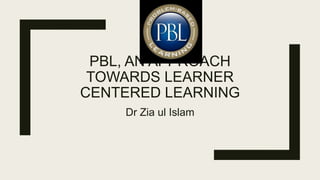
PROBLEM BASED LEARNING IN MEDICAL EDUCATION
- 1. PBL, AN APPROACH TOWARDS LEARNER CENTERED LEARNING Dr Zia ul Islam
- 2. Introduction ■ Problem-based learning (PBL) as a teaching strategy and curricular design began over more then fifty years ago at McMaster University in Canada. ■ The PBL process was pioneered by Barrows and Tamblyn at the medical school program at McMaster University in Hamilton in the 1960s ■ PBL reverses the traditional approach to teaching and learning ■ It starts with individual examples or problem scenarios which stimulate student learning
- 3. How it is started ■ Problem-based learning did not appear out of the blue but had several precursors: First in the work of Dewey who established an experimental school at the University of Chicago based on the idea that learning is more interesting if the learner is actively involved in his own learning The second source of influence was the Case Study Method pioneered at Harvard University in the 1930s of the previous century. The third source of influence to be described is Jerome Bruner’s “learning by discovery” from which the idea that a problem could be the starting point for learning originated
- 4. How it works? ■ PBL is both a curriculum and a process As a curriculum It consists of carefully selected and designed problems that demand from the learner`s acquisition of critical knowledge, Problem solving proficiency, self-directed learning strategies, and team participation skills. As a process It replicates the commonly used systemic approach to resolving problems or meeting challenges that are encountered in life and career
- 5. As an Instructional strategy ■ Problem-based learning (PBL) is an instructional method that challenges students to "learn to learn," working cooperatively in groups to seek solutions to real world problems ■ These problems are used to engage students' curiosity and initiate learning the subject matter ■ PBL prepares students to think critically and analytically, and to find and use appropriate learning resources ■ PBL can be used as a framework for modules, courses, programs, or curricula
- 7. Advantages Facilitates the acquisition of basic competences It encourages a deep approach to learning It prepares students for the adult learning approach they need for a lifetime of learning in the health care professions PBL helps in curriculum planning by developing core knowledge Ensuring relevance of content Integrating student learning and providing them with model cases
- 8. Disadvantages ■ Students may fail to develop an organized framework for their knowledge ■ Student Unpreparedness. . ■ Time-Consuming Assessment. ■ It may inhibit good teachers sharing their enthusiasm for their topic with students and student identification with good teachers ■ Teachers may not have the skills to facilitate PBL ■ Inadequate resources
- 9. Characteristics of a Problem-based Activity ■ An ill structured, complex problems provide the focal point(s) and stimuli for the learning process ■ Learning is student-centered ■ Teacher acts as a coach or facilitator. ■ Students work in small groups to solve/provide multiple solutions to problems ■ Learner assessment is enhanced by self and peer assessment.
- 10. Enhance students’ achievement of Application of problem solving in new and future situations Creative and critical thought Adoption of holistic approach to problems and situations Successful team collaboration Identification of learning weaknesses and strengths Promotion of self-directed learning Effective communication skills Leadership skills
- 11. It helps student in Construct an extensive and flexible knowledge base Develop effective problem-solving skills Develop self-directed, lifelong learning skills Become effective collaborators Become intrinsically motivated to learn.
- 13. Approaching the Problem(s) ■ 1. Introducing the concept and rationale for use of a PBL problem within the course/ module/unit ■ 2. Setting the stage. a. Roles and responsibilities of the various group members. b. In PBL, the recommended group size is from 4to 6 students. Each student can take (and hopefully rotate) the role of leader / encourager, reporter / skeptic, animator / presenter and recorder / scribe.
- 14. 4.Encountering and working on the problem Hypotheses Information Learning Issues Action Plan Evaluation Brainstorming What data do you have? List of what is needed to acquire additional data and complete the problem. Activities needed to be done in order to complete the problem. Is the problem solved? Does the process need to be repeated?
- 15. 4. Self-directed study 5. Problem follow-Up a. Resources identified and evaluated b. Summary of problem c. Reassessment of problem 6. Group evaluation
- 16. 7. Knowledge abstraction and summary a. Definitions, concepts, abstractions & principles outlined b. Diagrams, lists, concept maps, flow charts generated 8. Self and peer assessment 9. Facilitator assessment